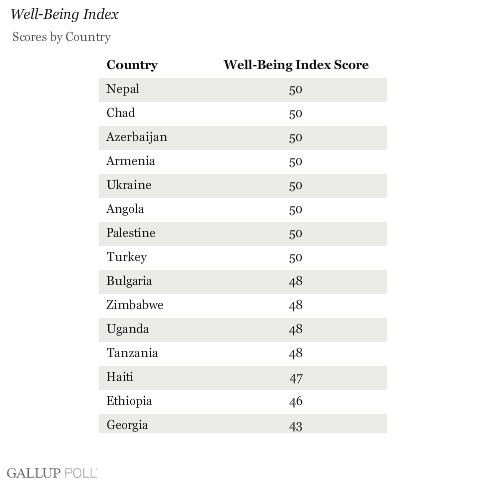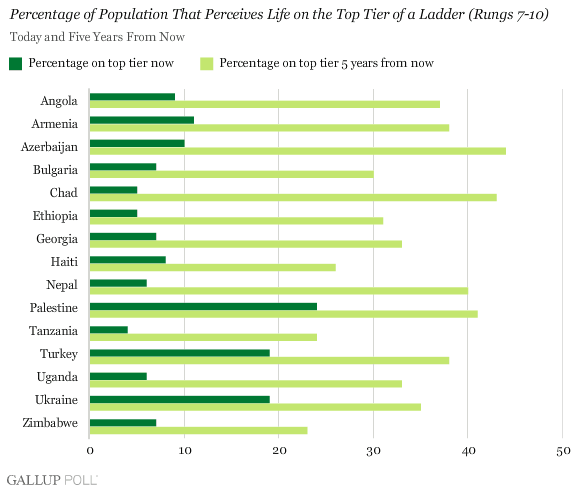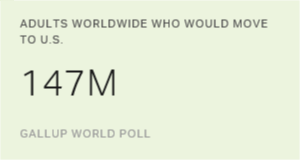WASHINGTON, DC -- Gallup polling in more than 130 countries finds citizens from nations throughout Africa and in Central and South Asia, Eastern Europe, and the Caribbean reporting the lowest subjective well-being. Although the countries span many regions of the globe and may lack a common historical or cultural background, they do share similarities on key economic indicators. The countries with the lowest Well-Being Index scores, as calculated from responses to a series of questions asked in Gallup's World Poll, all have per-capita GDP at purchasing power parity (PPP) below $11,000. Further, 10 of the 15 countries had strong economic growth in 2006 -- 5% growth or greater in real GDP -- and an average growth rate of 11.5%.

One pillar of Gallup's Well-Being Index is the evaluative or Cantril Self-Anchoring Striving Scale questions, in which the respondent is asked to place his or her life on a rung of a metaphorical ladder, with "0" being the worst possible position and "10" being the best. When asked to rank where their lives stand today, the average response for citizens in the low well-being countries is the fourth rung -- three rungs below the median of the 12 highest well-being countries.
Although the populations in these countries are less than optimistic about their current lives, they do display momentum and hope for the future. When asked to predict where they might stand five years from now, the average response jumps to the sixth rung. What's more remarkable is how the percentages of respondents placing themselves on the bottom (rungs 0 to 3) and middle tiers (rungs 4 to 6) of the ladder shift dramatically upward. For example, when asked where they stand today, nearly 4 in 10 Angolans (38%) say they are on the bottom tier of the ladder, but when they think of the future just 4% of Angolans say they will be on the bottom. Nearly 4 in 10 Angolans (37%) predict they will be on the top rungs.

The other pillar of the Gallup Well-Being Index is made up of the experienced or affect questions, in which the respondents are asked to think about how they felt during a certain period. Among the countries with the lowest well-being, responses on these questions vary greatly. On each of the four affect questions, there is a difference of at least 34 percentage points -- and in some cases nearly 50 -- between the lowest and highest responses. For example, only 17% of Georgians report having learned or done something interesting the day before the survey -- significantly lower than any of the other populations and a full 40 percentage points lower than Zimbabweans (57%).
Well-being researcher and Gallup Senior Scientist Ed Diener, Ph.D., has shown that a country's GDP is strongly correlated with the ladder questions but not as strongly correlated with the affect questions. This is evident in the list of countries with the lowest Well-Being Index scores: All of the countries have low per-capita GDP, yet the relationship between GDP and the affect questions appears less pronounced. What's more, Diener finds that GDP growth rates are negatively correlated with the affect questions, meaning that as GDP growth goes up, positive response rates for the affect questions go down. In Armenia, which posted a GDP growth rate of 13.4% in 2006, less than half of the population (48%) smiled or laughed a lot or experienced a lot of enjoyment the day before the survey, and slightly more than one-third (36%) say they learned or did something interesting during that same period. The same pattern is true in Azerbaijan, a country with a reported GDP growth rate of 34.5% in 2006. Only 43% of the population reports smiling or laughing a lot the day prior to the survey. In contrast, 75% of Zimbabweans say they smiled or laughed a lot -- on par with the percentages reported in high-GDP, high-well-being countries.
Survey Methods
Results from the Gallup World Poll are based on telephone and face-to-face interviews conducted throughout 2005 and 2006. Randomly selected sample sizes typically number 1,000 residents, aged 15 and older, in the countries polled. For results based on samples of this size, one can say with 95% confidence that the maximum error attributable to sampling and other random effects is ±3 percentage points. In addition to sampling error, question wording and practical difficulties in conducting surveys can introduce error or bias into the findings of public opinion polls.
